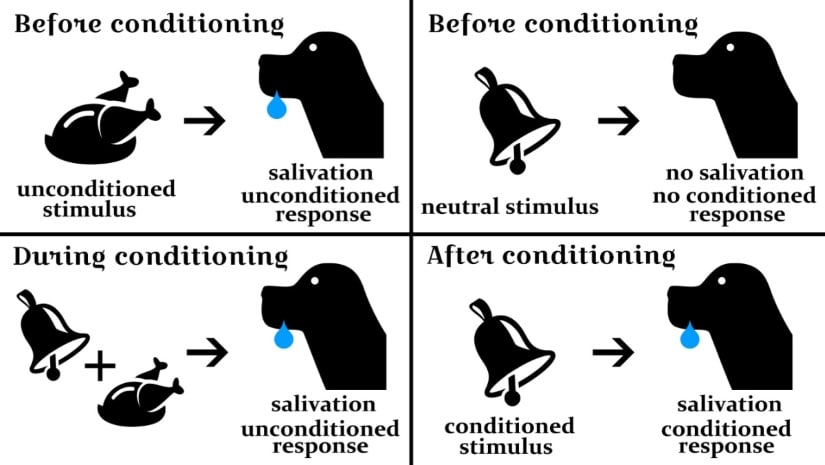John arrives home from work and even though he is tired, he takes his dog Jasper out for a walk. Jasper does “his business”, and now John is finally relaxing in his chair… then suddenly John notices Jasper has begun to chew on the kitchen table leg. Not again JASPER! he screams. COME HERE! Jasper reluctantly comes to him and John uses punishment on him by smacking him with a rolled up magazine. BAD BOY! John smacks him again and Jasper whimpers and goes off to a corner. “Hopefully one day that dog will learn to behave,” John mutters to himself. Then, he begins to wonder why his efforts to teach Jasper to behave don’t seem to be working.
We all want to curb our dog’s “bad” or unwanted behaviors. They are annoying, they frustrate us, and we just want them to stop. Of course there are many dog trainers and training courses out there. But they are expensive, time consuming, and the systems are complicated to implement. They also require a lot of effort on the owner’s part. As a result, many pet owners avoid professional training methods. Instead, they opt to try their hand at punishing their pets in order to try to make them behave. Others have taken courses and/or studied the reward-based training methods. Yet when they find themselves under stress or feeling frustrated, they revert to the primal instinct of lashing out at a misbehaving pet and try to punish the behavior away.
Punishment is a seemingly easy and straightforward training method. That is, our fur babies do something we don’t like, – poop or pee on the floor – chew on something they shouldn’t – and we scream at them, or scream and smack them on the behind or on the nose. Later, we may feel bad about this and comfort our baby. Other times we may be in a really good mood and our dog does the behavior he/she did yesterday that was punished, but today we think it is cute and laugh. Then we don’t understand why our dog isn’t learning not to do the behavior. Even worse, we may notice after using punishment for a while that their dog is now acting funny. He/she isn’t as affectionate as they once were. What is going on?! What is happening?
In this article I will try to explain exactly what punishment is, the requirements for using punishment effectively, and the unwanted consequences or side effects that have been well documented by scientists who study learning theory.

What is Punishment?
In 1898, Edward Thorndike formally defined the concept of punishment when he published his Law of Effect.
The Law of Effect states that “responses that produce a satisfying effect in a particular situation become more likely to occur again in that situation, and responses that produce a discomforting effect become less likely to occur again in that situation.” Wikipedia.
A few years later, B.F. Skinner would refine the second half of Thorndike’s law regarding reducing the frequency of behavior by dividing it into two distinct training methods. That is, a “discomforting effect” that reduces the frequency of a behavior can be produced two different ways. 1) We can remove a pleasant stimulus following a behavior which Skinner termed “Omission Training” but we commonly call it a time out. And, 2) we can present an aversive stimulus (something painful or unpleasant) following a behavior that reduces the future likelihood of that behavior which he termed Punishment.
How Does Punishment Work?
While the exact mechanisms are not known, research clearly points to an adaptive/survival advantage. For example, a predator that attacks a porcupine and gets “stung” with sharp quills is more likely to survive and pass on his/her DNA if they learn from the experience and never attack another porcupine. Those that keep on attacking porcupines would have died from starvation or infection. So learning quickly to avoid painful experiences would greatly help any animal to survive. Through decades of research and thousands of experiments, some basic principles of punishment have clearly emerged. Among these principles, the three requirements for punishment to be effective are as follows:
Three Requirements For Punishment To Be Effective
- It must be Immediate
- It must be Severe
- Punishment must be Consistent
The Importance Of Immediacy When Using Punishment

It is important for punishment to immediately follow the behavior in order to be effective. This is especially true in animal studies as animals have no verbal capacity to connect a punishment with a prior act. Experiments have also shown that every second that passes between the behavior and the presentation of punishment greatly decreases its effectiveness. If your dog does something you don’t want him/her to do i.e. go into the street, then it takes you 2 minutes to call and coax your dog to get out of the street and come to you before punishing them, two things have occurred:
- too much time has passed between the behavior of going into the street and the punishment for the punishment to be effective and
- the behavior immediately preceding the punishment was to come to you, not going into the street.
As a result, instead of punishing him/her for going into the street, you actually punished him/her for coming to you. That will reduce the likelihood that your dog will come to you in the future when you call them.
The Importance of Severity When Using Punishment
Whatever you use as a punishing stimulus must be severe in nature. That is it must be strong enough to elicit pain in order for it to be effective. If you say in a mildly irritated voice “no baby” and gently smack them on the nose, then that is not an aversive stimulus and will have absolutely no effect on their behavior. In fact, if it is too gentle it might even serve as a positive reinforcer and increase the likelihood of that behavior in the future. Then we come to the ethical issue.
Do we really want to use a training tool that we will need to cause actual pain in our pet in order for it to be effective? Each person must wrestle with this dilemma before using punishment as a training tool.
Have you ever punished one of your pets, perhaps out of anger or frustration, then almost immediately we are overcome with regret and sorrow? If we hold and caress our pet and tell them we are sorry, it completely negates the effect of the punishment. We are punishing, then rewarding the behavior.
The Importance of Consistency When Using Punishment

Finally, and sometimes the hardest requirement, is that punishment must be consistent in order for it to be effective.
- Every time the behavior occurs, the response must be the same
- Punishment cannot depend on your mood
- You must strive to not become angry, make a contingency in your mind that when X behavior occurs – Y punishment will follow every time
If you are tired you might not have the energy to punish them and “let it slide” this time. Or you might be frustrated, get angry, and punish your dog for something that normally isn’t punished. That change in your response to his/her behavior severely confuses the dog. The rules by which you apply punishment or not need to be consistent and not dependent on your state of mind or the punishment will have little or no effect on their behavior.
Rules For Punishment to Be Effective
- Actively monitor your dog’s behavior
- Make specific rules for what behavior will be punished and how
- Be prepared to immediately punish severely your dog after every infraction
- Be consistent in your application of punishment
As you can see, punishment takes a bit of effort to apply effectively. It can work, but I recommend that you use it as sparingly as possible. Those who overuse punishment typically tend to notice that while their dog is not doing the bad behaviors as frequently as before, they also notice a change in their personality. They seem shyer and don’t snuggle or play with them as they used to. Why is this?
Why Does the Overuse of Punishment Cause Harm?
Well, the answer to this lies in another line of research. I’m sure that you have heard of Ivan Pavlov. He was a Russian physiologist who was studying digestive reflexes in dogs. He hooked test tubes to the salivary glands of dogs to measure the amount of salivation produced by putting meat powder in the dog’s mouth. However, after 2 or 3 trials, the dogs began salivating before the powder was applied. The mere appearance of the lab tech was enough to cause salivation. He later paired a bell with the meat powder and found that the sound of the bell alone would cause salivation. That is, the simple pairing of a neutral stimulus (bell) with a stimulus that naturally produced a reaction (meat powder) could, after several pairings, cause the salivation response.
How Is A Bell And Salivation Related To Punishment?

Enter the Psychologist John B. Watson. He wondered whether this conditioned learning by pairing to stimuli could extend to emotions. In 1920 he published arguably his most famous paper Conditioned Emotional Reactions which clearly showed that emotions, too, could be conditioned through a simple pairing of stimuli. He was working in a Baltimore hospital and had access to the daycare children. Without permission (unfortunately) he took one of the young children (Albert) from the daycare to his laboratory.
He presented the child with a white bunny rabbit. In the moment that Albert reached out to touch the rabbit, Watson struck a loud bell/gong right behind Albert’s head. The loud sound scared Albert and he began to cry. The next day he presented Albert with the Rabbit and Albert was visibly scared of it and began to cry again. This important paper, while ethically flawed, showed that pairing an aversive stimulus with a neutral stimulus produces a fear of the previously neutral (rabbit) stimulus.
In the same way, conditioned fear is also produced when someone is using punishment as a training tool. That is, the pet owner is pairing his/herself with a painful aversive stimulus. The same way as when Watson paired the rabbit and the loud sound for Albert. Thus, our dog will be conditioned to fear us more and more each time we punish him/her. In turn, that fear will begin to break the loving bond that we dog lovers have worked so hard to build. This is the unintended side effect of punishment that so very few pet owners are aware of. On the other hand, when we use positive reinforcement, which is presenting a positive stimulus (e.g., treat or affection) following a behavior the same principle applies. That is, we are creating a positive association or emotion between ourselves and our pets.
The Bottom Line Regarding The Use Of Punishment In Training

So to put it all together, yes it is true that punishment can reduce unwanted behaviors. However, effective punishment is not easy to employ and most people who use it are not using it in an effective manner. Hopefully the case has been made that the rules for using punishment effectively are complicated. Punishment can reduce unwanted behavior, but it comes at the cost of producing conditioned fear of the pet owner. Therefore, for those who choose to use it, I strongly recommend that punishment be used sparingly and only for behaviors that might put the dog or someone else in danger.
Robert T. Burkey, Ph.D.
Dr. Burkey holds a Ph.D. in Behavioral Pharmacology from Texas A&M University and taught animal learning and behavior at Emory and Henry College in Emory, Virginia for 6 years. He and his partner Maria breed Siberian Huskies and French Bulldogs in Cameron, NC

Wow! That’s really good. I just hope those who are trying to train their pets understand it.